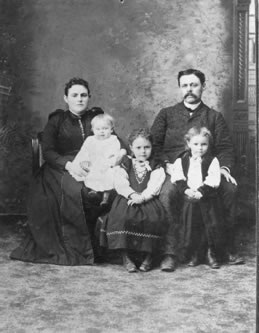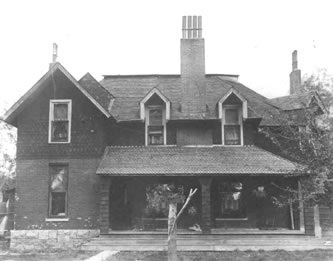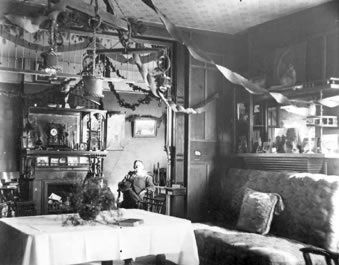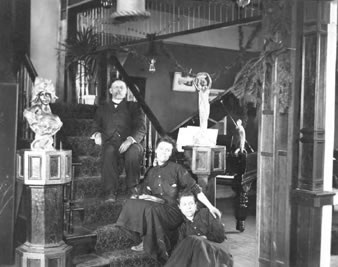Culp Family

Samuel T. Culp family, c.1891. Mr. and Mrs. (Adelaide) Culp and their three daughters, Cecelia (b. 1889), Ida (b. 1886), and Adelaide (b. 1887).
Samuel Thaddeus, also known as S. T., Culp, built a brick complex of stores in downtown Littleton in 1891-1892. Known as the Culp block, it stretched from Prince Street along the south side of Main almost to mid-block. He had bought the property from F. W. Ostrander and declared his intention of building five storefronts. One of the first occupants was O. M. Hurst, who, the newspaper announced, would be starting a furniture, crockery, carpet and undertaking establishment May 1, 1892. In March 1893 Bob Nelson took advantage of the current popularity of bicycling to rent a room formerly occupied by a restaurant in the Culp block and put in a stock of bicycles and bicycle supplies. By April 1895 Nelson's advertisement in the Littleton Independent described his shop as "The Wheelmen's Headquarters." He also carried tobacco, confectionery, sportsman's goods and soft drinks of all kinds.
A June 1901 photograph shows Browning's Barber Shop and a store called "The Fair," that may have been a grocery, in the Culp block. In 1905 Henry H. Curtis, Jr.'s jewelry store was one of the occupants. There was definitely a grocery in the west end of the building in 1914. It was Page Brothers Grocery and Bakery. On September 22, 1915 the Lux Theater opened in the Culp block. The first movie theater in Littleton, it showed three silent films each week and the first talkie in 1928.
S. T. Culp was a watchmaker and jeweler; his shop was in the Culp block, too. These businesses in his multi-shop building are a few typical examples of the variety offered to Littleton residents as Main Street began to grow in the late 1800s and early 1900s.
Samuel T. Culp was born October 26, 1851in Niagara Falls, Canada to Isaac Hendy Culp and Margarite Cecelia Thorpe. He learned his trade from a cousin in Toledo, Ohio during the years 1864 to 1869. In 1872 he married Miss Annie McArthur. They had six children, three of whom died at birth. Their one son lived to adulthood, but died young. One daughter and the mother, Annie MacArthur Culp, died of tuberculosis. The surviving daughter from this marriage was May Culp who became a schoolteacher in Toronto.
Samuel Culp made and sold his jewelry, traveling widely. In a brief history of his life that he wrote later, he said that he had lived in Canada from 1881 to 1885. He was remarried in 1884 to Miss Adalaide Ida Bigelow, the daughter of O. Bigelow of Lindsay, Ontario. Their first daughter, Ida, was born August 16, 1885.
S. T. said that he went to Los Angeles in 1886 and back and forth between there and Denver until 1888. He also suffered from tuberculosis; possibly he came west in search of sunshine and fresh air, for he did recover his health. During this time the family traveled to Shoshone, Idaho to investigate some land that he considered taking up. The Littleton newspaper later described that trip, saying that they went by prairie schooner up through Jackson Hole, Wyoming, "when that section was largely occupied by outlaws, and further hazard was risked when [they] passed through the none-too-friendly Shoshone Indian reservation." They found that the land in question was no good, but during their stop in Shoshone their second daughter, Adelaide, was born February 9, 1887.
The family was in Littleton by May 1889 when their two daughters were baptized in St. Paul's Episcopal Church. On October 16 of that year, their third daughter, Cecelia, was born, and she was baptized at St. Paul's a year later in October 1890. A fourth daughter was stillborn in September 1891. More sorrow came when daughter Ida died September 2, 1893 at age eight. Both the infant and Ida are buried in the Littleton Cemetery.
As told above, Samuel Culp built his first Littleton business block in 1891-1892. But the family is found in Victor, Colorado in the years 1895 through 1897. It was boom time in Victor and Cripple Creek. Mr. Culp had a jewelry shop in Victor, and while there he started Victor's post office and its first church. He hired the priest to teach his young daughters. The shop was lost when a fire swept through the town.
Culp had grubstaked a miner and watched his prospecting with interest. After drilling 100 feet with no success, they sold the mine. The next owner went fifty more feet and struck it rich with the 1895 Vindicator mine.
S. T. was an inventor of note and held several patents. He described one in his written history. It was a "movable float show stand" that he sold in the United States, Canada and Europe. One was displayed in 1892 in the 16th Street window of the McNamara Dry Goods store, forerunner of the Denver Dry Goods Company, in downtown Denver. It was the talk of the town. He also invented the "floating gardens of Mexico" that were featured at Elitch Gardens in Denver, as well as a device to weigh signatures. The Culp house was full of inventions.
In the forty years S. T. Culp lived in Littleton, he was active in business and civic affairs. It is said that he eventually owned thirteen stores on Main Street. These included some on the north side of Main Street, opposite his original Culp block. At his death the newspaper editor said, "He had engaged in many political and business skirmishes in Littleton, and he was always outspoken with his praise or criticisms." Some would consider him opinionated. When annoyed he never hesitated to take pen in hand to dispatch a letter to the newspaper, which he expected to be printed, word for word.
Described as generous to a fault, Mr. Culp was quoted as having said that his mother had once made him promise never to refuse food or assistance to those in need. "I always followed this pledge," he said. "No man ever came to my home for food and went away hungry."
In Littleton the Culps first belonged to St. Paul's Episcopal Church where S. T. served on the vestry and as church treasurer in the early 1890s. St. Paul's was often short of money, and he once proposed that the church begin charging members rent for its pews. The bishop nixed the idea. In 1891 when he was appointed to collect a fund for the support of a clergyman for St. Paul's, he published an open letter to all people of Littleton and the surrounding country that urged everyone, St. Paul's member or not, to subscribe, and included the list of names and pledged amounts of those who had already signed up.
The family later removed to the Christian Science Church, possibly when St. Paul's closed between 1917 and 1919. In the 1920s they supported the Littleton Methodist Episcopal Church.
During World War I Mrs. Culp, in a letter to the Independent, offered to drive mothers whose sons were away in the war. Mr. Culp wrote to encourage local businessmen to give jobs to returning soldiers.

Samuel T. Culp home, 5554 S. Prince St.. The house was built by Mr. Culp in 1890 and demolished in 1974.
The Culps built a fine large home in 1890 that sat squarely in the center of four city lots that ran all the way between Prince and Harrison streets. (Harrison is now Sycamore Street.) Their granddaughter, Betty Johnson Morrison, said that the Culp house actually faced both streets, with a "front" entrance on each street. That is, either side could have been considered the front entrance--remember that Thaddeus Culp had definite ideas about how he wanted things--and the driveway ran all the way through between Prince and Harrison. Morrison said, however, that the Harrison Street address was probably used first, and early newspaper items seem to have used the Harrison Street address for the Culps. The house was the showplace of the town at that time. (It later was divided into two residences. Today the addresses would be 5554 South Prince and 5555 South Sycamore.)
The Culps were a musical family. Mrs. Culp was an excellent pianist, Adelaide played piano and harp and had an outstanding four-octave voice, and Cecelia played piano and mandolin. Mr. Culp's instruments were guitar and banjo; he also sang in the choir when they belonged to St. Paul's Episcopal Church. They gave many parties for the girls where they provided musical entertainment and rolled up the rugs for ballroom dancing.

Samuel T. Culp in the sitting room of the Culp house, 5554 S. Prince St., c.1906. This photo shows small dining and living room adjacent to the sitting room.
Daughter Adelaide married Ernest Milton Rhea October 18, 1911 in an elaborate wedding at the Culp home. Electrically-lighted Chinese lanterns were strung the length of the driveway, and the house was full of flowers. The newspaper account said that after their honeymoon, the newlyweds would be at home in their little house on the Skelton Ranch. (According to the Littleton Museum, there was a Skelton Ranch at Federal Boulevard and Belleview.)
When Cecelia married Neal Brown Johnson, Jr., October 6, 1915, the scene was repeated; one of the Beers sisters was Cecelia's bridesmaid. Neal Johnson was a rancher on the Western Slope. He and Cecelia met when she taught school in Molina, a town in Mesa County, Colorado, after graduating from Colorado State Teachers College in Greeley. Cecelia's proud father was so pleased with the wedding that he invited the next Littleton bride to hold her wedding at the Culp house. The lengthy newspaper accounts of each sister's wedding were accompanied, not by a photograph of the bride, but by one of Mr. Culp in front of their house.
Samuel Thaddeus Culp was a brilliant, eccentric and complex man. Adelaide Bigelow Culp was brought up to be a lady and never departed from that tradition. At one time, Samuel decided that each family member should learn one aspect of his trade. To daughter Adelaide he assigned jewelry-making , to Cecelia, it was clocks, and Mrs. Culp was to learn watch repair. She stoutly and dramatically refused. She preferred her china painting and oil painting and produced some quite good work. She was extremely talented at the piano and could play any music set before her. Afternoons were for calling or receiving callers, and she never varied this routine, sometimes to the consternation of Mr. Culp.

Samuel T. Culp and two of his daughters, Adelaide (middle) and Cecelia (bottom) on the main staircase of the Culp House, c.1906. Behind them is the entrance to the parlor.
On Easter morning, March 30, 1929, Samuel Thaddeus Culp died suddenly at his home. He was working at his watch shop the day before. The newspaper said, "For his advanced years [seventy-seven] Mr. Culp was energetic and active. Until the last he retained his forceful and positive character." Coming as it did, shortly before the economic crash of autumn 1929, the family had a lot to deal with. To complicate matters, daughter Cecelia Culp Johnson died the following December 11, 1929 in Molina, leaving two small daughters, and the mother, Mrs. Adelaide Culp, died on December 26, 1929-three family deaths in ten months.
At S. T.'s death, Adelaide Culp Rhea and her husband, Ernest, returned to Littleton from Arvada where they had been farming and moved into the house with her mother. By then it had been divided into two living quarters; the east side continued to have the Harrison (later named Sycamore) Street address while the west side was rented out and used the Prince Street address.
Ernest Rhea, Adelaide's husband, became a licensed electrician and did occasional electrical contracting. He and his wife built a large store on some of the Culp property on the north side of Main Street that they leased to Safeway. He also remodeled the old Lux Theater in the original Culp block, and it became the Vogue Theater. He died April 29, 1952.
Adelaide Culp Rhea lived in the big Culp house until she died March 2, 1966. At her death memorial funds were donated to Arapahoe Junior College, now Arapahoe Community College, to provide short-term loans to entering students. The Culp house was eventually divided into apartments, and in 1974 it was demolished.
The Culp business block on the south side of Main Street has undergone major changes. Ulva Clair Thomas had a real estate office in the east corner unit in the early 1950s. In 1954 he tore down that unit and built a new brick building. It later housed Littleton Stationers.
The building that was the Lux, and later the Vogue, theater is currently occupied by a restaurant. The west part of the original Culp block was occupied by Jose's Restaurant until 2014 when Jose and his wife Phyllis retired from the restaurant business. The Alley Restaurant is now in the former Jose's Restaurant location on Main St.
Bibliography
Hulse, Doris Farmer. "History of St. Paul's Episcopal Church." St. Paul's Episcopal Church, 1870-1919, and St. Timothy's Episcopal Church, 1951-1983, of Littleton, Colorado. Littleton, Colorado: Columbine Genealogical and Historical Society, Inc., 1995.
Littleton, (Colo.) Independent, Littleton Independent Publishers, 1888-
Littleton Museum, Card file: Culp and Culp Block; Photographic Archives.
Methodist Episcopal Church of Littleton records. Financial secretary records.
Morrison, Betty Johnson, Denver, CO, telephone interviews by Doris Farmer Hulse, March 4-5, 2001.
Mount Rosa Chapter, National Society of the Daughters of the American Revolution. Littleton Cemetery, Littleton, Colorado. Littleton, Colorado: Mount Rosa Chapter, National Society of the Daughters of the American Revolution, 1983.
St. Paul's Episcopal Church records. Registers, vestry minutes.
Simmons, R. Laurie and Thomas H. Simmons. "Historic Buildings Survey. Littleton, Colorado. Littleton Townsite of 1890." Survey Forms. Three Volumes. Denver: Front Range Research Associates, Inc., 1997, 1998.
Photographs courtesy of the Littleton Museum unless otherwise noted. To order copies, contact the museum at 303-795-3950.
Compiled by Doris Farmer Hulse
Updated March 2021 by Phyllis Larison